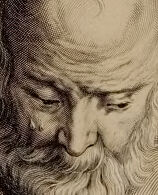Machine Generated Data
Tags
Clarifai
created on 2023-10-26
Imagga
created on 2022-01-22
Google
created on 2022-01-22
| Beard | 90.6 | |
|
| ||
| Human | 89.5 | |
|
| ||
| Art | 86.7 | |
|
| ||
| Facial hair | 83.2 | |
|
| ||
| Wrinkle | 81 | |
|
| ||
| Painting | 79.7 | |
|
| ||
| Handwriting | 78.5 | |
|
| ||
| Illustration | 76.4 | |
|
| ||
| Drawing | 72.9 | |
|
| ||
| Self-portrait | 70.6 | |
|
| ||
| Visual arts | 69.7 | |
|
| ||
| History | 66 | |
|
| ||
| Sitting | 64.9 | |
|
| ||
| Stock photography | 64.4 | |
|
| ||
| Moustache | 62.2 | |
|
| ||
| Circle | 60.9 | |
|
| ||
| Printmaking | 60 | |
|
| ||
| Paper | 59.8 | |
|
| ||
| Portrait | 57.8 | |
|
| ||
| Prophet | 57.5 | |
|
| ||
Color Analysis
Face analysis
Amazon

AWS Rekognition
| Age | 52-60 |
| Gender | Male, 99.4% |
| Sad | 98.3% |
| Calm | 0.7% |
| Confused | 0.4% |
| Fear | 0.3% |
| Disgusted | 0.1% |
| Angry | 0.1% |
| Happy | 0.1% |
| Surprised | 0% |
Feature analysis
Categories
Imagga
| paintings art | 99.8% | |
|
| ||
Captions
Microsoft
created on 2022-01-22
| a man holding a book | 63.1% | |
|
| ||
| an old photo of a man holding a book | 63% | |
|
| ||
| a man sitting in a chair holding a book | 55.4% | |
|
| ||
Text analysis
Amazon

angularem

Herman

cum

olorum

Ecce

E

Reg.

in funda

pinxit.

C.Lauwers

Apost

Weyen

Herman Weyen ext: cum prinil Reg.

uou

Io.coffiers pinxit.

prinil

E foras

24.B

C.Lauwers feulpfit

Io.coffiers

uou 24.B Crystala angularem шпшитр

ext:

foras

feulpfit

amare

Petres amare

Crystala

Petres

يوم

шпшитр

TV

Brilleps

unun
uou un
rylata 2 B,
lo. caffiers pinxit
punf
angularem
Ccce
C.Lauwers feulpfit .
torum
egrefjiar foras
tre floit onare

unun

un

rylata

2

B,

lo.

caffiers

pinxit

punf

angularem

Ccce

C.Lauwers

feulpfit

.

torum

foras

floit

uou

egrefjiar

tre

onare


